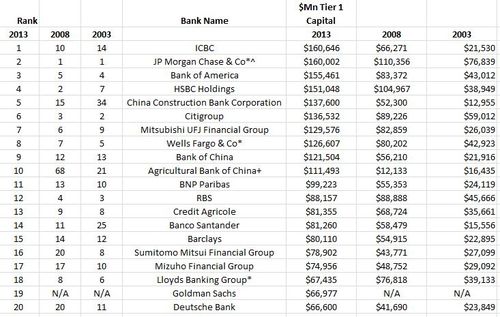
I was just analysing the
Banker’s annual tome: the Top 1,000 banks.
It’s a serious piece of research and represents many years
of trends and change (I’ve personally now been tracking the Top 40 banks from
this list for the past twenty years!).
This year’s figures reinforce the things I’ve been expecting
for some time: that China’s banks now rule.
China’s Big Four banks are rapidly becoming the safest in
the world, according to their levels of Tier 1 capital reserves.
Obviously this is not the single factor needed to review a
banks stability, as it needs to be related to return on assets, return on
equity, cost-income ratio and more, but it does provide a good indicator of who’s the daddy when you compare like
for like.
What was interesting for me this year was to look at the past
ten years and note the changes made by the mergers of JP Morgan with Bank One
and Washington Mutual; Wells Fargo with Wachovia; RBS with ABN AMRO; and Lloyds
and HBOS.
These changes make a significant impact on the rankings over
the past ten years and also shows some spectacular improvement and wastage of capital,
based upon the rankings.
For example, the Chinese banks have all shown a spectacular
rise in capital over the past decade, mainly due to the move of these banks
from state ownership to private investment.
The Chinese banks have all moved through full or semi
privatisation over the past decade:
- Bank of China (2006)
- China Construction Bank (2004)
- Industrial and Commercial Bank of China (2006)
- Agricultural Bank of China (2010)
And this has had the most significant impact on their Tier 1
Capital holdings as a result.
Meanwhile Japanese banks have been hit heavily during the past decade, mainly due to stagflation in the Japanese economy, as have the European banks.
Deutsche Bank dropped
nine ranking slots, RBS are down seven, whilst Rabobank, ING and Unicredit have dropped out of the Top 20:
- Unicredit (21 in 2013 versus 16 in 2008)
- ING Bank (26 in 2013 versus 17 in 2008)
- Rabobank (27 in 2013 versus 20 in 2008)
The only other notable hit in the list over the past decade is Citigroup, with a drop of four places. Unsurprising when you think of TARP, bailouts and all the other crap that has hit the fan over teh past five years, although some might say that it is down to management
errors.
Nevertheless and either way, the fact that all of the banks are still
in the Top 20 shows their resilience to this crisis and these challenges, so here’s the one chart I can share here: the Banker’s Top 20 bank rankings 2003, 2008 and 2013 (doubleclick image to enlarge):

* represents 2008 combined results of banks merged: JP
Morgan and Washington Mutual; Wells Fargo and Wachovia; Lloyds and HBOS; and
other rankings reflect these merger changes
^2003 combines results of JP Morgan, Washington Mutual and
Bank One; Wells Fargo and Wachovia; Lloyds and HBOS; RBS and ABN AMRO; and
other rankings reflect these merger changes
+ Agricultural Bank of China was the last of China's Big
Four banks to IPO in 2010, which is why Tier 1 Capital has changed so
significantly
Chris M Skinner
Chris Skinner is best known as an independent commentator on the financial markets through his blog, TheFinanser.com, as author of the bestselling book Digital Bank, and Chair of the European networking forum the Financial Services Club. He has been voted one of the most influential people in banking by The Financial Brand (as well as one of the best blogs), a FinTech Titan (Next Bank), one of the Fintech Leaders you need to follow (City AM, Deluxe and Jax Finance), as well as one of the Top 40 most influential people in financial technology by the Wall Street Journal's Financial News. To learn more click here...

